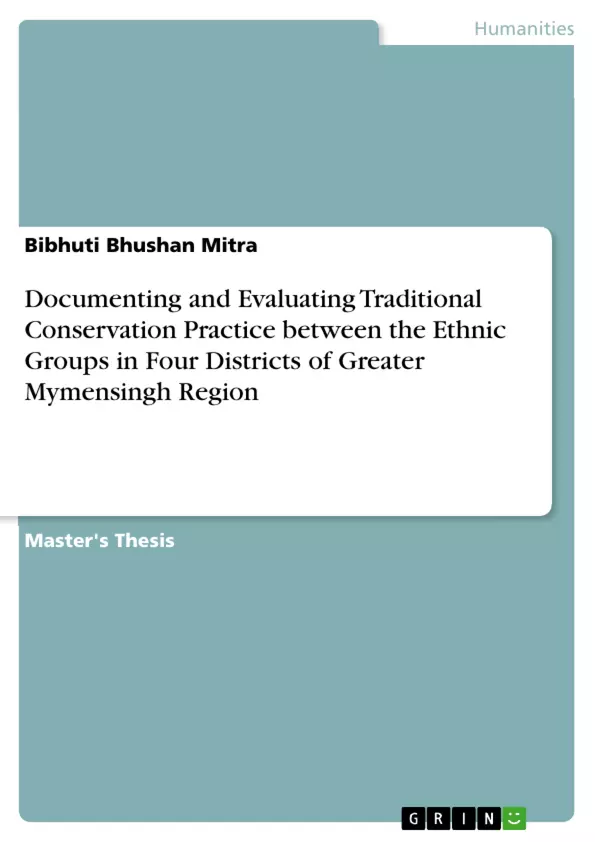
Documenting and Evaluating Traditional Conservation Practice between the Ethnic Groups in Four Districts of Greater Mymensingh Region
Masterarbeit, 2006
55 Seiten, Note: 01
Leseprobe
CONTENTS
ACKNOWLEDGEMENT
1. INTRODUCTION
1.1. General
1.2. Review of literature
1.3. Aims and objectives
2. STUDY AREA
2.1. Bangladesh
2.2. Study site
3. METHOD
4. RESULTS
4.1. Overall Documentation
4.2. Documentation of animal use for the conservation purpose by different ethnic communities
4.3. Documentation of plant use for the conservation purpose by different ethnic communities
4.4. Documented dominant animal species in different sacred groves
4.5. Documented plant species in different sacred groves
5. DISCUSSION
6. RECOMMENDATION
7. REFERENCES
APPENDIX
Details
- Titel
- Documenting and Evaluating Traditional Conservation Practice between the Ethnic Groups in Four Districts of Greater Mymensingh Region
- Hochschule
- Jahangirnagar University
- Note
- 01
- Autor
- Bibhuti Bhushan Mitra (Autor:in)
- Erscheinungsjahr
- 2006
- Seiten
- 55
- Katalognummer
- V365664
- ISBN (eBook)
- 9783668489080
- ISBN (Buch)
- 9783668489097
- Dateigröße
- 744 KB
- Sprache
- Englisch
- Schlagworte
- documenting evaluating traditional conservation practice ethnic groups four districts greater mymensingh region
- Produktsicherheit
- GRIN Publishing GmbH
- Preis (Ebook)
- US$ 20,99
- Preis (Book)
- US$ 30,99
- Arbeit zitieren
- Bibhuti Bhushan Mitra (Autor:in), 2006, Documenting and Evaluating Traditional Conservation Practice between the Ethnic Groups in Four Districts of Greater Mymensingh Region, München, Page::Imprint:: GRINVerlagOHG, https://www.diplomarbeiten24.de/document/365664
- Autor werden
- Ihre Optionen
- Vertriebskanäle
- Premium Services
- Autorenprofil
- Textarten und Formate
- Services für Verlage, Hochschulen, Unternehmen

- © GRIN Publishing GmbH.
- Alle Inhalte urheberrechtlich geschützt. Kopieren und verbreiten untersagt.
- info@grin.com
- AGB
- Open Publishing
Der GRIN Verlag hat sich seit 1998 auf die Veröffentlichung akademischer eBooks und Bücher spezialisiert. Der GRIN Verlag steht damit als erstes Unternehmen für User Generated Quality Content. Die Verlagsseiten GRIN.com, Hausarbeiten.de und Diplomarbeiten24 bieten für Hochschullehrer, Absolventen und Studenten die ideale Plattform, wissenschaftliche Texte wie Hausarbeiten, Referate, Bachelorarbeiten, Masterarbeiten, Diplomarbeiten, Dissertationen und wissenschaftliche Aufsätze einem breiten Publikum zu präsentieren.
Kostenfreie Veröffentlichung: Hausarbeit, Bachelorarbeit, Diplomarbeit, Dissertation, Masterarbeit, Interpretation oder Referat jetzt veröffentlichen!
- GRIN Verlag GmbH
-
- Nymphenburger Str. 86
- 80636
- Munich, Deutschland
- +49 89-550559-0
- +49 89-550559-10
- info@grin.com
-









